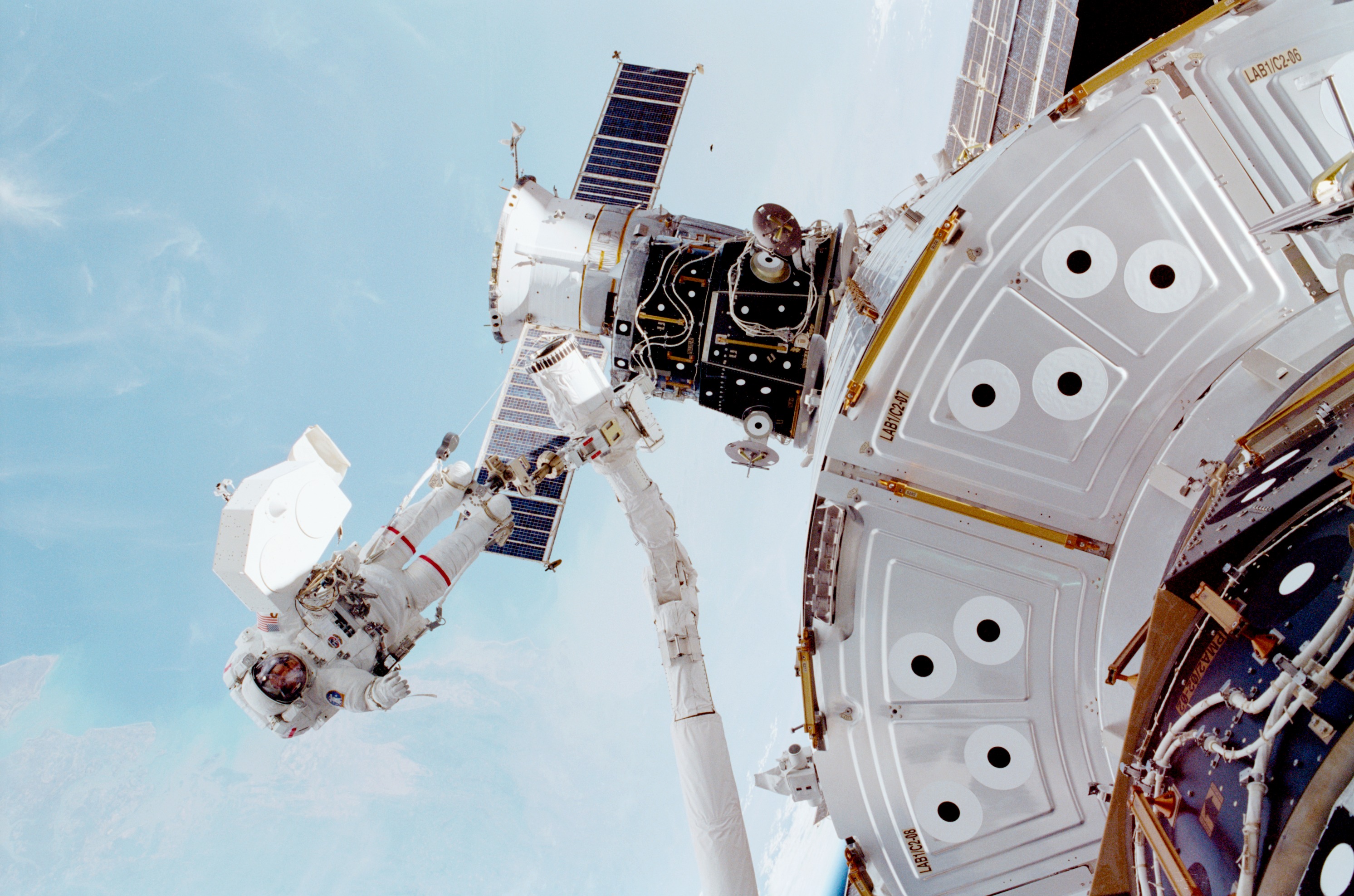
Over the course of five decades, no fewer than 211 individuals from 10 sovereign nations—Russia, the United States, France, Germany, Japan, Switzerland, Canada, Sweden, China, and Italy—have departed the pressurized confines of their spacecraft and observed the Home Planet from the unique vantage point of low-Earth orbit. Since the world’s first Extravehicular Activity (EVA), by Soviet cosmonaut Alexei Leonov in March 1965, and America’s first spacewalk, by U.S. astronaut Ed White the following June, men and women have carried out repairs, constructed and maintained the International Space Station (ISS), and even journeyed to the Moon itself. Over the next 10 days, to commemorate 50 years since the first U.S. EVA, AmericaSpace will be looking back at 10 key accomplishments of U.S. spacewalking history. We begin with the long and short of it all: (arguably) the longest and shortest EVAs of all time.
With 187 spacewalks performed in support of ISS construction and maintenance—extending from STS-88 in December 1998, through to the most recent EVA by astronauts Barry “Butch” Wilmore and Terry Virts on 1 March 2015—it would appear unusual to select the first EVA of shuttle mission STS-102, way back in March 2001, as a starting point. Spacewalkers Jim Voss and Susan Helms were tasked with helping to relocate Pressurized Mating Adapter (PMA)-3 aboard the station and install an attachment fixture atop the U.S. Destiny laboratory. Yet theirs became the longest EVA in history, at eight hours and 56 minutes, a record which still stands to this very day.
STS-102, launched on 8 March 2001, was intended to deliver Voss, Helms, and their Russian crewmate Yuri Usachev to the ISS as the station’s second long-duration crew, as well as returning the Expedition 1 crew of U.S. astronaut Bill Shepherd and Russia’s Yuri Gidzenko and Sergei Krikalev to Earth. Additionally, the STS-102 crew—which also comprised Commander Jim Wetherbee, Pilot Jim “Vegas” Kelly, and Mission Specialists Andy Thomas and Paul Richards—were assigned to support a pair of EVAs and deliver equipment and supplies aboard the first flight of Italy’s Leonardo Multi-Purpose Logistics Module (MPLM).
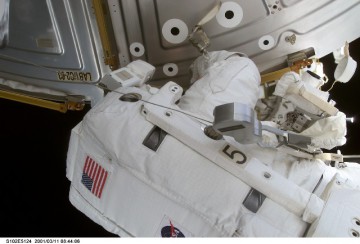
According to the STS-102 Press Kit, the opening EVA of mission was scheduled to take place on the fourth day of the flight, with Voss designated “EV1,” with red stripes on the legs of his space suit for identification, and Helms as “EV2,” clad in a pure-white suit. Voss already had two previous EVAs to his credit, including STS-69 in September 1995, when he participated in tests of ISS construction tools and equipment. “Voss and Helms will help relocate PMA-3 from the lower berthing port on the Unity node to an adjacent berthing port on Unity’s left side,” the press kit detailed. “That is being done so the MPLM can be docked to the Common Berthing Mechanism (CBM) of the lower port. Voss and Helms will start their spacewalk jobs by preparing for the PMA-3 move.”
The two spacewalkers departed Shuttle Discovery’s airlock at 12:12 a.m. EST on 11 March, thereby kicking off the 17th EVA in support of ISS construction and maintenance. They expected to spend a little over six hours outside. Things did not get off to a good start, when a hydrazine detection package floated into space, requiring Voss and Remote Manipulator System (RMS) operator Kelly to perform an unplanned maneuver to retrieve it. “This was an exciting EVA,” lead spacewalk planner Kieth Johnson said later. “You’re always interested when the first thing the crew says when they open up the hatch is: ‘Oops, we lost a few pieces of hardware!’”
Less than a half-hour later, Voss reported that the Portable Foot Restraint Attachment Device (PAD) had become untethered and drifted away. After consultation with Intravehicular (IV) crewman Richards, who in turn spoke to Capcom Gerhard Thiele in the Mission Control Center (MCC) at the Johnson Space Center (JSC) in Houston, Texas, a spare PAD was identified in a storage location on the exterior of Unity. Voss collected the spare PAD and pressed on with his next task. That task—the detachment and “de-facing” of eight cables between PMA-3 and Unity—also proved problematic, when the very first connector (“606”) stubbornly refused to budge as Voss tried to reconnect it. “It’s not my day, apparently, Paul,” he glumly told Richards at one point. “The very first connector … I am unable to release the bale completely. It came about halfway and stuck. I’m working on it.” At length came Voss’ eureka moment: “I got it! It just took a whole lot of force.” The remaining connectors also proved tighter than anticipated, but eventually came free. During one quiet period, Helms wished her mother a happy birthday, little realizing that by the time she and Voss returned inside Discovery they would have established a new EVA record which still stands to this day.
With the cables detached, the spacewalkers set to work mounting the 300-pound (136-kg) Lab Cradle Assembly (LCA)—“like a small truss with a claw on it,” according to Voss— from an Integrated Cargo Carrier (ICC) in the shuttle’s payload bay onto the aft zenith trunnion of the U.S. Destiny laboratory module. This would provide a position for the installation of a pallet containing the Canadarm2 robotic arm during the next shuttle flight, STS-100 in April 2001. Although they encountered no difficulties with the cradle assembly, by the time they had completed this task they were almost an hour behind schedule, and a previously planned objective to connect video and data cables in a rigid umbilical onto the LCA was deferred, in order to allow them to press on with the PMA-3 relocation. Launched in October 2000, the adapter was to be moved from the Earth-facing (or “nadir”) interface of the Unity node, but had to be transferred to its port side, in order that the Leonardo Multi-Purpose Logistics Module (MPLM) could be temporarily installed.
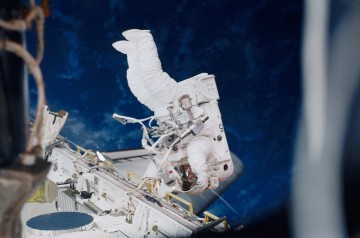
This was a particularly complex task, for Discovery was docked onto the forward end of Destiny and, to the astronauts on the shuttle’s aft flight deck, the station rose like a tower from the payload bay, completely obscuring their view of the PMA-3 worksite. Although they could rely upon camera views and the Space Vision System (SVS), it was also highly desirable to have visual cues and, where necessary, verbal commands from Voss and Helms to guide them into position. “We have to move this Pressurized Mating Adapter from one face of the node, around 90 degrees to another face,” said Andy Thomas in a pre-flight interview. “Normally, when we do things like this, we have lots of systems that provide the alignment and visual cues to do the mating. It turns out that, with this particular configuration, we don’t have a lot of those cues, so we’re going to be using the EVA crew persons potentially to help us with that task.”
At length, Voss and Helms were directed back to Discovery’s airlock, where they hooked up their space suits’ utilities to the orbiter’s internal power supplies, after six hours and 43 minutes. It was intended for them to stand by as Thomas robotically detached PMA-3 from Unity nadir and maneuvered it to its new position at Unity port. This period of standing by turned out to last far longer than intended—close to three hours, in fact—as their crewmates struggled to get PMA-3 berthed, due to problems with a television positioning system. Voss and Helms’ EVA officially ended at 9:08 a.m. EST, after eight hours and 56 minutes, breaking the previous record of eight hours and 29 minutes, set during the Intelsat 603 retrieval in May 1992, and creating a record-setting spacewalk whose duration remains unchallenged, even midway through the second decade of the 21st century.
“We knew this one was going to be tough, because it was ambitious, it was success-oriented,” said STS-102 Lead Flight Director John Shannon. “We had many, many discussions as to whether this day had too much stuff in it and it was right on the edge, I think. But we decided that, hey, if we could get this stuff done, we ought to get it done while we were out at vacuum.”
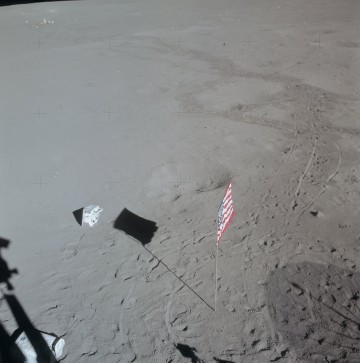
At the opposite extreme, arguably the shortest “EVAs” were those which dealt with perhaps the most unglamorous element of spacewalking: the dumping of unwanted equipment into space, or, on several occasions, onto the surface of the Moon. One such instance came on 20 July 1966, when astronauts John Young and Mike Collins briefly opened the right-side hatch of their Gemini X spacecraft for about three minutes to do just that. “There was one final, simple EVA to perform,” Young wrote in his memoir, Forever Young. “We opened the right hatch and, to reduce our weight, Mike threw out a large duffel bag into which we had crammed the Extravehicular Chest Pack, the umbilical, empty food packages and everything else we no longer needed.” In his autobiography, Carrying the Fire, Collins remembered wedging himself “way, way down” in the footwell on his side of the tiny cabin, before dumping the cabin pressure, “so that the hatch will swing open and closed a good six inches above my head.” All went well and Collins pitched the “tremendous” bag into the void of space. “The next time my hatch opens,” he wrote, ruefully, “the only thing I want to worry about is blue Atlantic sea gushing in.” For the first time in three days, with the unneeded detritus now gone, Young and Collins could stretch their legs … and were also able to dig out the Gemini X Flight Plan, which had been hidden under all the junk.
Similar, short-duration “EVAs” were performed on each of the piloted lunar landings, between Apollo 11 in July 1969 and Apollo 17 in December 1972. Each lasted for no longer than two minutes and required the Moonwalkers—after ascending the ladder into the Lunar Module (LM)—throwing their unnecessary lunar overshoes, Portable Life Support System (PLSS) backpacks, empty food containers, spent lithium hydroxide canisters, and urine and fecal waste bags out onto the surface. “To achieve jettison, the astronauts had to depressurize their cabin once again, refitting their helmets so they could open the hatch,” explained Neil Armstrong’s biographer, James R. Hansen, in First Man. “It was almost like performing another EVA Prep, though this prep took less than 20 minutes and did not involve any hose-swapping or donning of the [backpacks].”
The items thrown out—in what Hansen wryly called “lunar littering”—were common to each Apollo mission, and included the backpacks, “their cooling water drained into a plastic bag that was then stowed,” which bounced off the porch on their way down to the surface. “We could get down far enough in our pressurized suits to reach the backpacks with our gloves,” Armstrong told Hansen, “and then tossed them, rather than kicked them out, as later crews did.” The impacting thuds were captured by the seismometer, installed earlier on the surface. Only one small part of the Left-Hand Side Stowage Compartment (LHSSC) failed to make it down to the surface, lodging on the edge of the LM’s porch.
A similar protocol was followed on each of the successive lunar landings. On Apollo 12 in November 1969, Pete Conrad admitted that he kicked the backpacks out of the LM’s cabin. “I got a clean kick on both of them,” he told Capcom Ed Gibson. “In other words, when they left the hatch, they departed the hatch and free-fell all the way to the ground without touching the ladder or anything on the way.” Colorful descriptions from Apollo 16 in April 1972 also indicate that John Young kicked the backpacks out of the cabin.
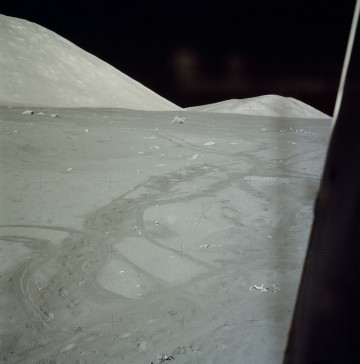
The last lunar litterers were the landing crew of Apollo 17, astronauts Gene Cernan and Jack Schmitt. “Cameras, tools, backpacks and other now-useless material were flung to the surface,” Cernan wrote in his autobiography, The Last Man on the Moon. “We had to shed weight if we were going to get off the Moon safely. Mission planners had worked out the exact balance needed, and every container of rocks we brought aboard was weighed on a handheld fish scale, calibrated for one-sixth gravity, before being stored. We had just enough fuel to get us into orbit, with almost no margin for error, so the overall weight of the spacecraft, its passengers and cargo of rocks was critical. We threw out nearly everything that wasn’t nailed down!”
In the Apollo Lunar Surface Journal, it was noted by Cernan that one of the backpacks became “hung up” on the LM porch. “I had to get way out with my leg to get it unstuck,” he remembered, years later. “You didn’t have room to throw them out; you just had room to push them out.” Schmitt jokingly bemoaned that they did not have a broom aboard, in order to sweep out the copious amount of lunar dust. Uniquely, Apollo 17 actually performed two of these brief “EVAs,” the first to discard the backpacks and equipment, soon after their third and final Moonwalk, and another the following morning to dispose of final trash items.
“I guess we’re going for EVA-4,” Schmitt remarked, before the LM’s hatch opened for the second time for trash disposal.
“Five, isn’t it?” queried Cernan. It was, indeed, their fifth period in lunar vacuum, after three surface excursions and two hatch-open and hatch-closed trash dumps.
Schmitt corrected himself. “Five, this time?”
“A lot of things we would just set down in front of the hatch and—pop—just kick them out,” Cernan later recalled, quoted by the Apollo Lunar Surface Journal. “It was easy to enough to do that. Kick them far enough to clear the porch.”
From just two minutes betwixt hatch-open and hatch-closed on the surface of the Moon to almost nine hours toiling outside the International Space Station (ISS), extravehicular activity has achieved remarkable successes in the last half-century.
This is part of a series of articles to commemorate 50 years of U.S. Extravehicular Activity. Tomorrow’s article will focus on the repair of NASA’s Solar Max observatory by the crew of shuttle Mission 41C in April 1984, which represented a spacewalking challenge of far greater complexity than anything previously accomplished.
Want to keep up-to-date with all things space? Be sure to “Like” AmericaSpace on Facebook and follow us on Twitter: @AmericaSpace
Missions » US EVAs »




Thanks for this great series of reports Ben, and as always the beautiful high-rez images.
Question: NASA has well known protocols for Loss of Vehicle and Loss of Crew, but what about loss of a crew member during EVA? Disposition of the body, the appropriate notification to the families and the nation, national address by the president, and so on.
Thanks Ben,
-Steve